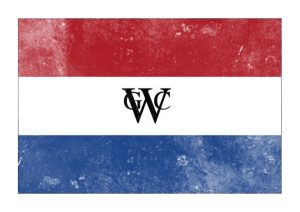
The Dutch established a presence along the Eastern seaboard more than a decade before the arrival of the Swedes in 1638. They sought to expand the colony of New Netherland, which was centered in present day New York state. In 1655, they took control of Swedish territory in the Delaware River Valley.
The Dutch had an even richer brewing tradition than the Swedes and, back in their native kingdom, an industry thriving on beer production and export. There were several Dutch breweries operating in New Amsterdam (present day Manhattan) and New Beeverwick (present day Albany) by the time they assumed control of New Sweden. As the center of the Dutch holdings in the Delaware region, the village of New Amstel (present day New Castle) had as many as three breweries operating during the Dutch reign from 1655-1664.

If he did not brew beer, Foppe Jansen Outhout certainly served plenty of it at his tavern along the Strand at the current location of the George Read House gardens. Outhout’s place was a popular meeting spot for villagers and soldiers stationed at Fort Casimir.
Another New Amstel tavern owner, Harman Jansen, was brought up before village authorities in 1657 for tapping beer that he brewed without paying an excise. Jansen is the first brewer identified by name in Delaware’s history.
Hendrick Hendricksen Kip (II) operated another brewery in New Amstel sometime after 1659 on what was known alternately as Bever (now called Fourth) Street. Kip sold his brewery and moved to Flatbush, Long Island around 1664, just before the English took control of the Dutch colony.
Reynier Reynertsen Vander Cooley purchased Kip’s property and appears to have continued the brewing and distilling business for a short time. He moved to Kingston, New York in 1665 but, in 1670, sold his brewing and distilling equipment and returned to New Castle. It is suspected that Vander Cooley may have again taken up brewing and distilling as a trade again in New Castle. In 1681, he was charged by the court with violating the law that prohibited the sale of liquor to indigenous people in the area.
Andries Hudde served the Dutch West India Company at Fort Casimir in several capacities beginning in 1651. Among his many assignments and vocations, Hudde was a practiced beer brewer. While no record has been found of Hudde’s brewing, he must have been skilled at it. The Company refused English attempts at recruiting Hudde to Maryland, as the Calvert colony was said to have no capable brewers. After a short tenure at Fort Altena (f/n/a by the Swedes as Fort Christina), Hudde was granted his discharge from the Company in 1663 and left to work as a brewer in Queen Anne’s County. Unfortunately, he only made it as far as Appoquinimy (present day Odessa, Delaware), where he died from malaria in November of that year.
Sometime after his arrival at New Amstel in December 1663, newly-appointed governor Alexander d’Hinoyossa had a brewery constructed inside Fort Casimir. The brewery utilized the 700-pound copper brewing kettle confiscated from the Swedes during the invasion of Fort Christina. Beer was the single most important export during d’Hinoyossa’s rule, and he traded it in large quantities with the English in Calvert’s Maryland in exchange for tobacco and enslaved Africans. Dubbed “the Little Prince” by detractors, d’Hinoyossa was an arrogant, cruel, and careless leader, who was more concerned with personal enrichment than the well-being of New Amstel. When the colony was short on wood, d’Hinoyossa ordered Fort Casimir’s wooden palisades be stripped as kindling for the brew kettle. Of course, this and other foolish actions by d’Hinoyossa left the fort and New Amstel more vulnerable to an inevitable English attack. d’Hinoyossa recognized his days were numbered at governor and began selling everything he could get his hands on to the English in Maryland, including the fort’s valued brew kettle.
Gerrett van Sweringen is a subject of interest because of his connection with New Amstel and beer brewing. While there’s no known record of Sweringen brewing at New Amstel, he lived in the town beginning in 1657. He served various positions while in New Amstel including sheriff, councilor, and deputy commander of the Delaware colony, under the employ of the City of Amsterdam. Sweringen developed strong business relationships with the English in Maryland, which would serve him well later. Unfortunately, Sweringen lost much of his estate and possessions during the English raid of New Amstel in 1664. He retreated to St. Mary’s City, the first capital of the Maryland colony, and operated a successful ordinary and brewery, eventually rising to a position of power and prominence in local government.
Like Sweringen, another brewer with a strong connection to New Castle who also probably did not brew in the town, is Pieter Wolfertsen van Couwenhoven. In 1669, five years after the Dutch ceded control of their colony to the English, Couwenhoven, a well-known brewer in Manhattan, purchased a lot in New Castle on Hart (now Harmony) Street, just northwest of Bever (now Fourth) Street. Couwenhoven likely never set foot in New Castle, though his name appears on the deed. By 1871, he was languishing in a Manhattan debtor’s prison. Couwenhoven’s daughter Annetje and her husband did live on her father’s property in New Castle for a few years until it was sold in 1673.
A valuable c1680 recreated map of English governed New Castle, showing several of the locations referenced above, can be found here.
